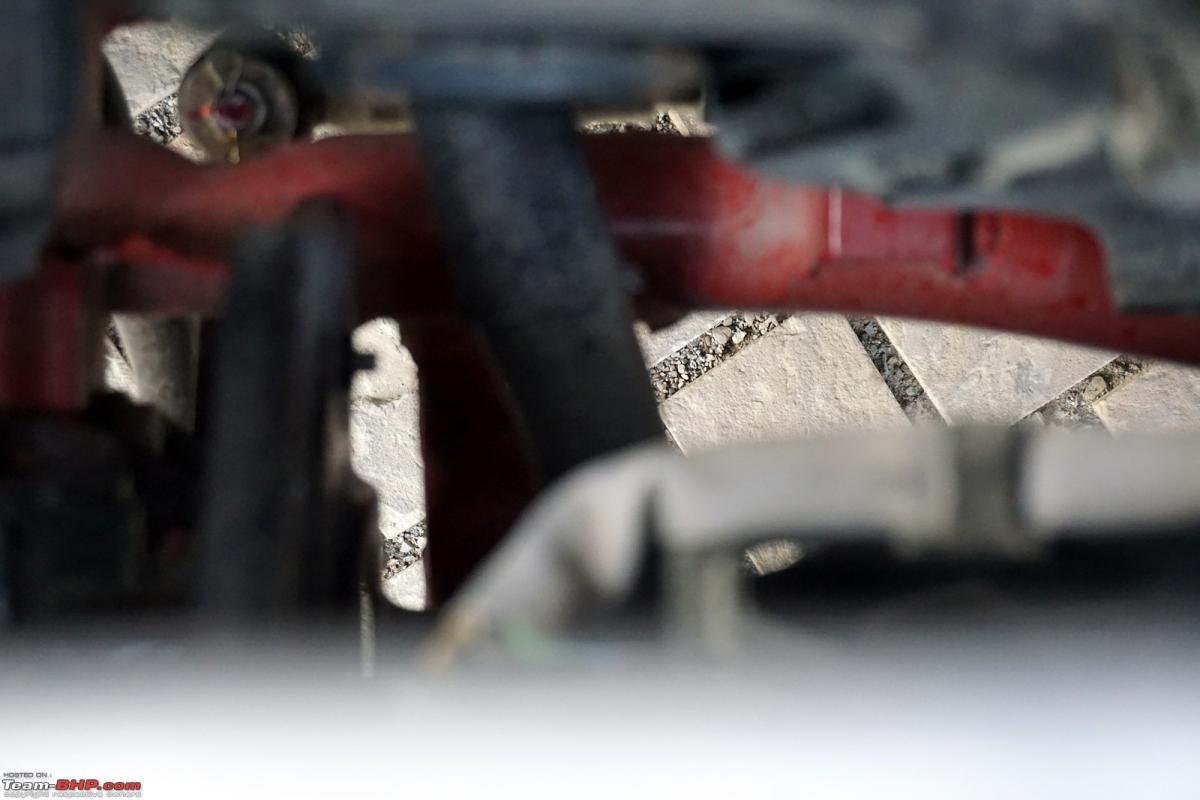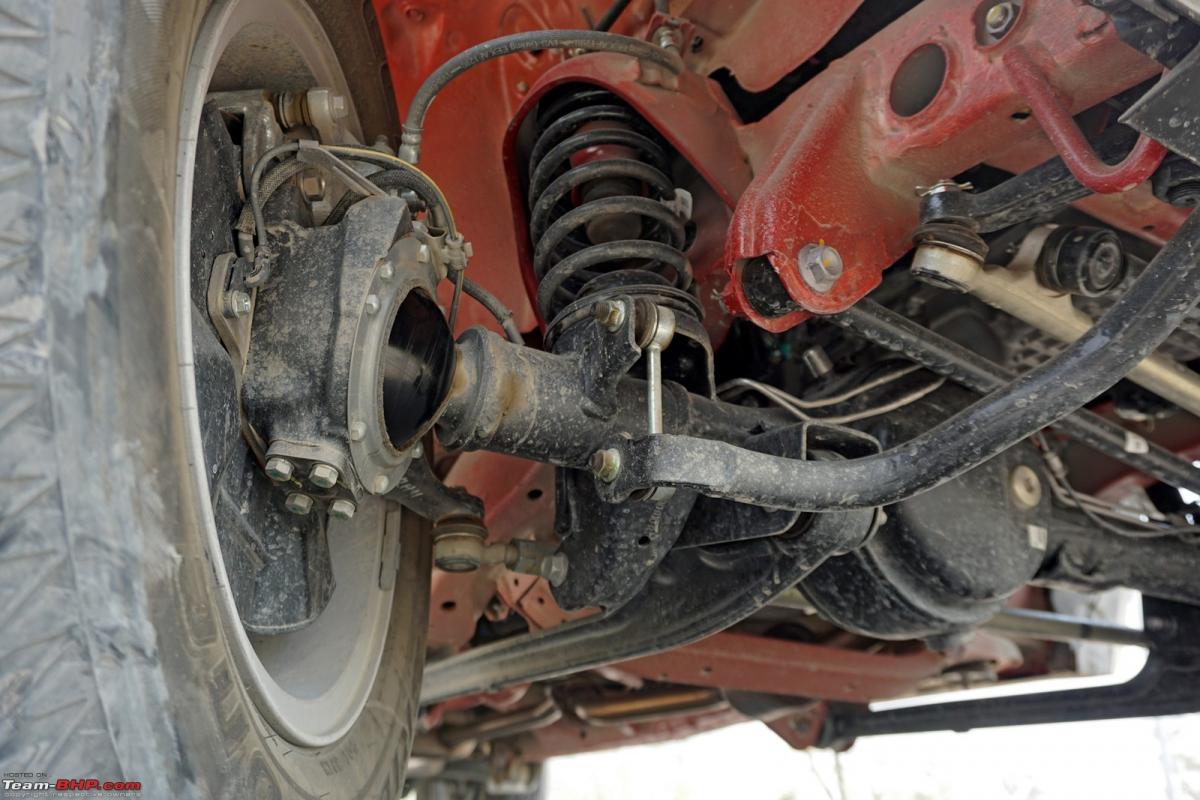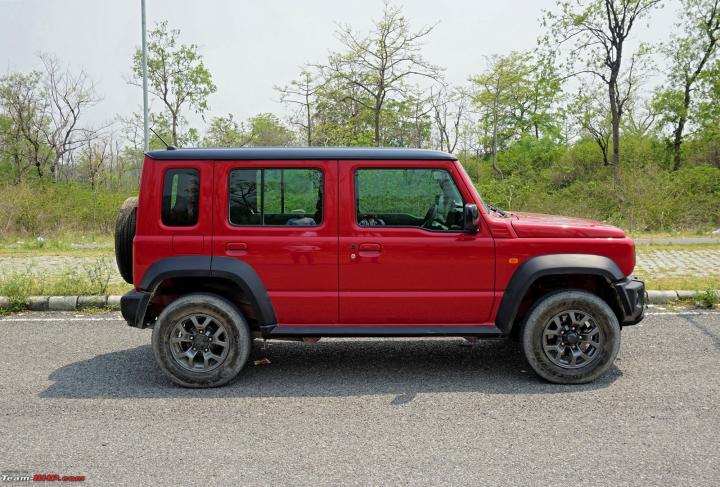News
Maruti Jimny : Our observations after a day of driving
The Jimny is an extremely capable vehicle off the paved road. It is equipped with rigid axle suspensions at the front & rear and Suzuki's AllGrip Pro shift-on-the-fly four-wheel drive system with 3 modes.
Driving the Jimny 1.5L Petrol MT
1.5L K15B engine is taken from the 2018 Ciaz & 2019 Ertiga / XL6. It is longitudinally mounted and doesn't get the Smart Hybrid system though. Air intake is routed behind the right headlamp:

The Jimny is powered by Maruti's 1,462cc, 4-cylinder K15B engine that puts out 103 BHP @ 6,000 rpm and 134 Nm @ 4,000 rpm. While the power figure is identical to the 2018 Ciaz and 2019 Ertiga, it must be noted that the Jimny weighs 1,195 kilos, which is more than its siblings. The torque has also been reduced by 4 Nm to 134 Nm. So the Jimny has lower power-to-weight and torque-to-weight ratios (86 BHP / ton and 112 Nm / ton) than its stablemates.
The Alpha variant is equipped with keyless entry & go. To start the car, press the clutch and hit the start button. The engine fires up with very little noise, but there is a noticeable shake of the gear lever. At idle, the engine is silent, but the gear lever shakes about and there are some mild vibrations felt on the seats.
Release the clutch gradually and the car moves forward without any throttle input. You can even pull away from a standstill in 2nd, albeit with some extra throttle input! Throttle response is satisfactory. Power comes in smooth & seamless. Low-speed drivability is good and in the lower gears, the car can pull reasonably well at anything over 1,000 rpm. The engine starts feeling comfortable above 2,250 rpm. Keeping up with the traffic is easy, but if you need to close a gap, a downshift might be required.
On the open road, the Jimny feels underpowered. Outright performance is below average. Rivals such as the Thar petrol will leave you in the dust. Overtaking slower vehicles on undivided highways requires some planning and aggressive downshifting. When pushed, the engine revs to 6,250 rpm and with a full load of passengers & cargo, you will need to work it hard. We feel that the rev limit of 6,250 rpm is very conservative. Sometimes, in the middle of overtaking manoeuvres, you have to shift up. The Jimny is more suited to a sedate driving style. It can cruise at 100 km/h in 5th gear with the tachometer reading ~3,000 rpm.
The clutch has a rather heavy action and a medium travel range. The 5-speed transmission has a heavy & notchy shift action too. This will get irritating in stop-go traffic. Add a heavier-than-usual steering and wide turning radius and you have a problem. Despite its small size, these factors prevent the Jimny from being a good city runabout. The AT should be a lot better though.
Noise, Vibration & Harshness (NVH)
Coming to NVH levels, there is no body shake on start-up or shutdown. However, as mentioned earlier, the gear lever moves about while the engine is being cranked and on idle. Vibrations are felt through the seats on idle as well.
The engine is silent while idling and acceptably refined at low revs. However, it is audible when revved. You can always hear the motor when you are accelerating. It starts getting loud post 3,500 rpm, and more so after 4,500 rpm. Near the redline, it whines and doesn't sound good. Wind noise starts creeping in above 80 km/h and gets louder as the speed increases. Road and tyre noise are both well-controlled.
Mileage & Fuel Economy
The 1.5L petrol engine comes with an idling start / stop function which enhances fuel efficiency. The MT and AT have ARAI ratings of 16.94 km/l and 16.39 km/l, respectively. We managed to see 8.5 km/l on the MID, but it must be remembered that there was a lot of idling, hard acceleration and braking involved in our drive. Better driving can easily yield 10 km/l or higher figures.
Heavy bonnet with no insulation underneath. The single manual prop rod is so flimsy, the hood sags at the unsupported end. A pneumatic one should've been provided:

Firewall has little insulation which results in engine noise entering the cabin:

Absolutely no underbody protection of any kind. Given the nature & use case of the vehicle, a bash plate is probably the first thing a lot of people would get:

Suspension
3-link rigid axle at the front...

...and rear:

Ride Comfort
The Jimny comes with a 3-link rigid axle suspension with coil springs at the front and rear. At city speeds every little bump is felt inside the cabin. However, it must be noted that both variants of the Jimny ride on 15" wheels with 195/80 section tyres and the recommended tyre pressure is 26 PSI. The tall sidewalls definitely help matters. So while the Jimny may not match some monocoque crossovers for ride comfort, it still outclasses the Thar in this field.
The tar roads around Dehradun were in good shape and finding large potholes was difficult. However, we did go off the road. Rough patches and dirt tracks posed no problem for the Jimny. It tackled them with aplomb and didn't cause any discomfort to the occupants. The car feels abuse friendly. The suspension works silently too.
Handling & Dynamics
We didn't get to drive very fast as the roads were passing through forests with corridors for wildlife. However, we did find an empty straight stretch away from the forest for a few short fast runs where we managed to touch 100 km/h. The high-speed stability of the Jimny at the speed was acceptable.
Through curves, the car holds its line well at regular speeds or even a bit higher. On twisty roads, you will experience some body roll but it's well-controlled for a body-on-frame vehicle. Our test car came with 195/80 R15 Bridgestone Dueler tyres, which provided enough grip at the speeds we were doing.
The Jimny's driving dynamics are certainly better than the Thar's and way better than the Gypsy's.
Steering
The Jimny comes with an EPS unit. It is also heavier compared to some other EPS units. It is not one-finger light at city or parking speeds, but we have no complaints. It is nice in the city with a decent amount of weight to it. On the highway, its reaction time is slow, but we actually prefer it this way in an off-roader that is not a great handler (sharp steerings are best suited to low-slung, tight-handling cars).
What we do not like is that the steering has a poor return to centre action. Though not as bad as some other Maruti cars, it does require correction. This can be quite a lot of work while tackling switchbacks in the mountains. The steering takes more rotations to accomplish the same turns compared to an ubiquitous rack & pinion setup, so driving around obstacles or parking in a tight spot will involve a decent arm workout.
Another problem is that the Jimny has a turning radius of 5.7 m, which is wider than the Force Gurkha's 5.65 m. This means you will be performing more 3-point turns than you'd like.
Braking
The Jimny is equipped with disc brakes at the front and drum brakes at the rear. The performance is as expected and the car comes to a halt without much drama. Under hard braking too, the car doesn't lose its composure.
Niggles & Problems
The 3-door version of the Jimny has been in production since 2021 and Maruti will have solved any problems that might have arisen. The engine and transmissions have been around for a long time and have proven durable and reliable. We did not face any problems in our test car and do not expect owners to do so either. However, as is always the case, we strongly recommend extended warranty coverage.
Like we saw in the Fronx, all the seatbelts have to be buckled in while the car is being driven, even if there is no other person in it other than the driver. If not done, the seatbelt alarm keeps sounding. Luckily the alarm stops after about 2 minutes of driving.
4x4 & Off-roading
The Jimny is an extremely capable vehicle off the paved road. It is equipped with rigid axle suspensions at the front & rear and Suzuki's AllGrip Pro shift-on-the-fly four-wheel drive system with 3 modes:
- 2H - Power is sent only to the rear wheels. This mode should be used for normal on-road driving (street and highway).
- 4H (high range) - Power is sent to all four wheels. This mode should be used for driving on gravel, sand, mud and other low-traction surfaces.
- 4L (low range) - This mode should be used for low-speed driving in extreme off-road conditions.
You can shift between the 2H and 4H modes on the go. Of course, getting in or out of 4L mode is only possible when the vehicle is stationary. The engaged mode is displayed on the MID.
"4WD engaged" indicator in the MID. Simple and clear:

Further, the Jimny also gets a brake limited slip differential, hill descent control and hill hold assist. The stats are very impressive. The Jimny has an approach angle of 36 degrees, a departure angle of 50 degrees and a ramp break-over angle of 24 degrees. However, its water-wading depth of ~300 mm is low compared to other offroaders.
Articulation and approach / departure / ramp break-over angles are fantastic in the stock setup. We didn't scrape the undercarriage pretty much anywhere however difficult the surface was to navigate:

This thing's called a mountain goat for a reason and we saw enough to say the moniker is well-earned:

Short overhangs and lumbar black scratch-resistant bumpers mean sharp inclines are dispatched matter-of-factly without any fuss:

210 mm ground clearance, 310 mm of water wading depth and the high air intake in the engine bay mean the Jimny can dispatch most water crossings even in stock form:

Continue reading the discussion on the Maruti Jimny on our forum.

















